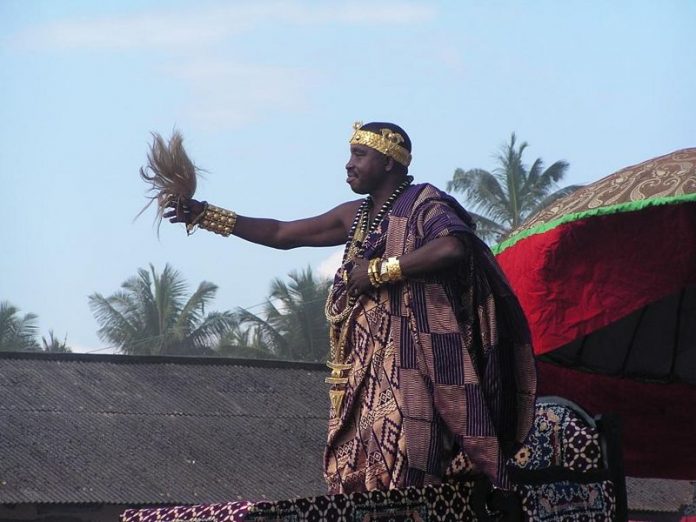Nkusukum is one of the matriarchal, highly educated, fearless, and agriculturalist Akan Mfantse-speaking people that form the subset of the larger Bɔrbɔr Mfantse (Fante) ethnolinguistic group. Nkusukum resides in the Mfantseman Municipality of the Central Region of Ghana and they are the custodians of the Nananom Mpow (The Ancestral Grove) of the Mfantse people. Thus, they are the first among equals within the larger Mfantse ethnic group.
The towns that makes up Nkusukum are Akyemfo (Saltpond), Yamoransa, Biriwa, Akatakyiwa, Asafora, Abeadze Dominase, Abeadze Kyeakor, Abonko, Nankesedu, Wuraba, Duadze, Abenum, Kuntu, Anokyi, Mpesedadze, Peyim, and some parts of Mankessim. Their capital city is Yamoransa, thus the paramount chief of Nkusukum Traditional Area is the Chief of Yamoransa. They have bold, fearless, and highly educated people from their land.
Migration and Place of Origin
Nkusukum were members of the Bɔrbɔr Mfantse who migrated from Takyiman in the ancient Bono Kingdom. The Bɔrbɔr Mfantse left Bono as a result of sibling rivalry and dynastic strife that emerged after the death of the Bono King. The Bɔrbɔr Mfantse were led from Takyiman by their three powerful Priest-Patriarchs, Oburumankoma, Odapagyan, and Oson. Bartels (1965: 55) contends that their names represented the three-tiered system of the natural order and the mastery that each animal is said to have had over its sphere. The three patriarchs had magical regalia and possessed mfoa ‘short swords’ signifying their judicial authority.
Whilst travelling from Bono to the south, Nkusukum moved together with Abora and Ekumfi with Nkusukum forming the “ridge” in the middle whiles the Abora moved on the nyinfa ‘right’ and the Ekumfi on the bɛnkum/atabɛn ‘left’. With this militaristic travelling strategy, the Mfantse came to settle at the back of River Pra and later crossed the Pra to reside at Kwamankɛse. Crayner (1989) explains that after staying at Kwamankɛse for many years, they moved on to settle at Adowegyir, which was then the settlement of the aboriginal Etsi under their ruler, Okraban Afor (Afful) also known as Nana Akraman. The Bɔrbɔr Mfantse fought the Etsi, defeated them, and drove them out of Adowegyir. After seizing Adowegyir from the Etsi, the Mfantse changed the town’s name to Ɔmankɛsemu ‘Big State’, later anglicised as Mankessim. They made Mankessim their traditional capital; the mortal remains of Oburumankoma (whale), Odapagyan (eagle), and Oson (elephant) were interred in the thicket of trees at the Nkusukum town of Obidan, near Mankessim. The place became in time the “habitat of ghosts [asamanpow] or spiritual powers inhering in nature [abosompow]” ((McCaskie 1990: 135).
Mankessim town was organised into five distinct mboron ‘quarters/wards’, Nkusukum boron was the southwest; Kurentsi Amanfo (now Mankessim) boron was the northwest; Ekumfi was at the southeast or Edumadzi boron; Enyan was at the north or Bentsir boron was the north; and the Abora were at the east or Anaafo boron (Crayner, 1989; Bartels, 1965; McCaskie, 1990). Here, the Nkusukum people became the custodians of the Nananom Mpow, thus the first among equals within the Bɔrbɔr Mfantse. This development was partly because of deference to age, experience, and leadership qualities. However, McCaskie (1990) contends that Nkusukum earned their foremost status principally because of the “nimbus of magical power” associated with their oversight of the ancestral grove.
Movement out of Mankessim
Population explosion in Mankɛssim in the middle of 1400s forced Bɔrbɔr Mfantse to move out of their traditional capital. The Nkusukum leader, Kwaw Okumko “Thursday-born Killer of Buffalo”, led his group out of Mankɛssim to settle at Nankɛsedo, from where Entsir Kodwo one of the elder’s and crab trapper went on to found Akyemfo (Saltpond). From Nankɛsedo, Okumko moved with his people to settle first at Biriwa, where he met strong resistance from the aboriginal Etsi so he and his people left their woman amongst them behind. Thus, Biriwa means “the place the old woman was left behind.” Okumko moved on to Akatakyiwa where he fought the Etsi again until he reached Yomoransa and the fighting end. Here, he poured libation with European liquor after defeating the Etsi, thus he gave the land its name Yamoransa, which means “the suffering drink” Thus, Kwaw Okumko became the King (First Paramount Chief) of Nkusukum, founder and the first Chief of Yamoransa.
Festival
Nkusukum celebrates Odambea Festival. Odambea derives its name from the role of the “ridge” the Nkusukum ancestors played in the Bɔrbɔr Mfantse migration. The Nkusukum formed the “ridge” in the middle whiles the Abora moved on the right and the Ekumfi on the left; and it is likened to the long beam that joins one end of a roof to the other end to make roofing possible “Odan-Mbeae” (Essamuah, 2004).
Sources
Bartels, Francis Lodovic. The Roots of Ghana Methodism. (Cambridge: Cambridge UniversityPress, 1965).
Crayner, Joseph Brandford. Bɔrboɔr Kunkumfi: The History of the Migration of the Fantes from Tekyiman to their Present Homes. (Accra; Bureau of Ghana Languages, 1989).
McCaskie, Thomas Conrad. “Nananom Mpow of Mankessim: An Essay in Fante History,” in D. Henige and T. C McCaskie, (eds.), West African Economic and Social History: Studies in Memory of Marion Johnson. (Madison: African Studies Program, University of Wisconsin, 1990).
Sanders, James Robert. “The Political Development of the Fante in the Eighteenth and Nineteenth Centuries: A Study of a West African Merchant Society.” (PhD Disssertation, Northwestern University, 1980)

